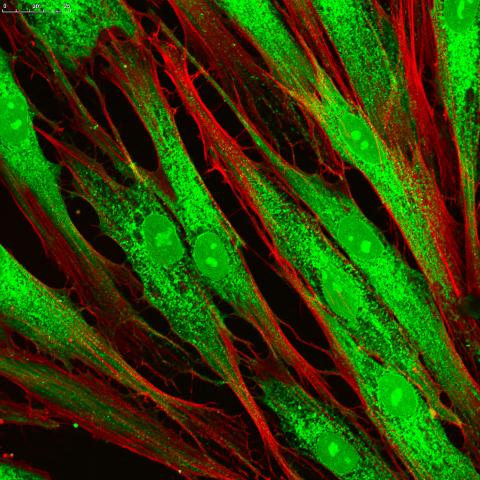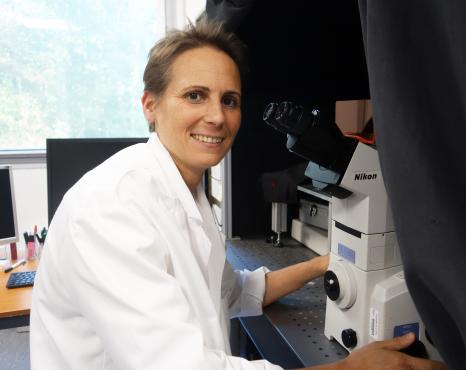
Marie Erard: A chemist tackling life head-on
Observing the organisation of matter
Marie Erard is a lecturer at the Institute of Physical Chemistry (ICP — Univ. Paris-Saclay, CNRS), where she has been Deputy Director since 2020. A specialist in the chemistry of living organisms, her work focuses on exploring how cells function at the molecular level. To achieve this, she is developing analytical methods based on fluorescence spectro-imaging. For the past few months, she has been coordinating BioProbe, an interdisciplinary project at Université Paris-Saclay, whose aim is to promote the development of innovative detection methods for the exploration of living processes.
With a long-standing interest in chemistry, Marie Erard discovered the field of chemistry coming from and destined for living organisms during an internship at the Pasteur Institute in her 1st year Master's degree. She passed her 'agrégation' in chemistry in 1999 and, drawn to research, embarked on a PhD in bioelectrochemistry. The subject of her thesis, Détection par ultramicroélectrodes de flux femtomolaires émis par une cellule vivante isolée : application au stress oxydatif et à l'exocytose de neurotransmetteurs (Detection of femtomolar flows released by an isolated living cell using ultramicroelectrodes: application to oxidative stress and the exocytosis of neurotransmitters), defended at the chemistry department of the École normale supérieure (ENS) Ulm in 2002, is not unrelated to her current research work at the Institute of Physical Chemistry (ICP). "I was already studying biological phenomena at the molecular level, using electrochemical tools." After a year as a post-doctoral fellow at the University of California, Riverside (USA), she was hired in 2003 as a lecturer at Université Paris-Sud (now Université Paris-Saclay) in the Laboratory of Physical Chemistry (LCP, which became ICP in 2020). Ten years later, she obtained her Accreditation to Supervise Research (HDR) and became a professor in 2016.
With a staff of 135, the ICP covers research fields rooted in chemistry, with projects at the interface with physics and life sciences. It is organised into four scientific groups comprising theoretical scientists and experimentalists. A seasoned experimentalist, Marie Erard works in the Physical Chemistry of Biological Systems (CPSysBio) group. Since her arrival in 2003, her work has focused on two lines of research: the development of fluorescent probes and biosensors based on fluorescent proteins for imaging, and the development of measurement strategies in living cells based on fluorescence spectro-imaging. "I like the idea of seeing matter organise and reorganise itself. I'm motivated by understanding the fundamental mechanisms of life. To analyse them, I'm developing strategies that rely on different types of imaging and using those fascinating tools known as fluorescent proteins."
NADPH oxidase and oxidative stress
To develop her projects, she sets her sights on an enzyme her scientific group had already studied: hydrogenated nicotinamide adenine dinucleotide phosphate (NADPH) oxidase. "Essential to human beings, it's a key player in the immune system. On the one hand, the enzyme is essential for destroying microbes in the event of infection, by generating what we call reactive forms of oxygen. On the other hand, the uncontrolled production of reactive forms of oxygen leads to oxidative stress and inflammation: the same type of phenomenon that causes wrinkles and sunburn."
Marie Erard uses fluorescence microscopy to observe the enzyme in vivo. "It's organised in blocks, and their assembly forms the functional structure. As early as 2003, my aim was to fuse a fluorescent protein to each of these blocks so as to identify, using the fluorescence signal, how it was assembled. My dream is to observe both the cells of the immune system that phagocytise and sequester microbes, and the assembly of NADPH oxidase and its production of reactive forms of oxygen. This step is important for identifying where to act to control the enzyme and limit the oxidative stress it induces."
This dream is not yet a reality, but Marie Erard has made some progress, thanks in particular to a successful collaboration with a team of cell biologists led by Olivier Nüsse, who joined the ICP in 2016. Together, they put forward the first complete structural model of the cytosolic component of NADPH oxidase in 2019. Marie Erard believes that these approaches, which require appropriate fluorescent probes, the right cell models and the development of high-performance instruments, are only possible thanks to the ICP's scientific and technical facilities.
The lecturer is currently involved in two programmes funded by the French National Research Agency (ANR): BoriProbe, in partnership with molecular chemists, and ApicoLipidTraffic, with biologists. "In the interdisciplinary ApicoLipidTraffic project, the aim is still to observe the phenomenon of assembly at a molecular level by measuring the fluorescence signal, except that it's not the components of an enzyme that are interacting, but membranes that are coming together."
Developing tools to probe living organisms
Since 2022, Marie Erard has been coordinating BioProbe, an interdisciplinary project of Université Paris-Saclay, with the aim of creating an interdisciplinary scientific community. Comprising some 40 teams and 250 people, it focuses on the development of methodologies and tools for probing living organisms at different scales, with applications in diagnostics and imaging. "BioProbe's research and education initiatives are now up and running, and they're very much appreciated by the community. We are beginning to focus on the area of innovation in conjunction with SATT Paris-Saclay and IncubAlliance."
BioProbe offers a call for research projects, provides travel grants for PhD candidates and post-doctoral fellows, and funds educational courses for laboratory research support staff. "We also organise a conference every two years to bring the community together, alternating with a summer school for PhD candidates. The first event, held in July 2023, with courses, practical work and interdisciplinary workshops, was a real success. I'm a great believer in the need for interdisciplinary learning." In the same vein, and to prepare students in advance for an interdisciplinary thesis, the BioProbe team has set up a specific programme between 1st year and 2nd year Master's degree. "The idea is to educate the student community through research in a discipline other than their 'major', be it physics, biology or chemistry," explains the lecturer, who draws on educational practices tried and tested elsewhere.
Supporting collaborative work
Marie Erard particularly enjoys mentoring her PhD candidates. "I like this mentoring role because, for me, it's where the scientific interaction is the closest. As they become experts themselves, PhD candidates can teach us things in turn." As Deputy Director of the Institute of Physical Chemistry, she coordinates various laboratory projects every year: "I enjoy this specific role because you can measure its impact on the organisation and people's working conditions directly, and within a reasonable time frame." This involvement reflects her taste for teamwork and interaction with colleagues from all walks of life. "One of my greatest satisfactions!" concludes Marie Erard.

